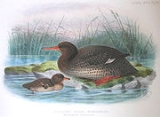
Auckland Islands Merganser
Encyclopedia
The Auckland Merganser or Auckland Islands Merganser (Mergus australis) was a typical merganser
which is now extinct.
This duck was similar in size to the Red-breasted Merganser
. The adult male had a dark reddish-brown head, crest and neck, with bluish black mantle and tail and slate grey wings. The female was slightly smaller with a shorter crest.
This bird was first collected when a French expedition led by the explorer Jules Dumont d'Urville
on the ships L'Astrolabe and La Zelee visited the Auckland Islands
in 1840. Its decline was caused by a combination of hunting and predation by introduced mammal
s. The bird was not flightless, but rather hard to flush; it preferred to hide between rocks when pursued. The last sighting was of a pair shot on January 9, 1902. It was not found in a 1909 search, and a thorough 1972/1973 exploration of possible habitat concluded that it was long extinct (Williams & Weller, 1974).
Subsequent fossil discoveries suggest that this merganser was previously resident on the South Island
and Stewart Island/Rakiura
in New Zealand
. Fossils of a subspecies or closely related species have also been found on the Chatham Islands
. There exists a short remark mentioning "a merganser" found on Campbell Island
in McCormick (1842), but this may just as well refer to the semi-marine Campbell Teal which is otherwise missing in his notes: he only mentions the Pacific Black Duck
("a New Zealand species of duck").
Mergus
Mergus is the genus of the typical mergansers, fish-eating ducks in the seaduck subfamily . The Hooded Merganser, often termed Mergus cucullatus, is not of this genus but closely related...
which is now extinct.
This duck was similar in size to the Red-breasted Merganser
Red-breasted Merganser
The Red-breasted Merganser is a diving duck.-Taxonomy:The Red-breasted Merganser was one of the many species originally described by Linnaeus in his 18th-century work, Systema Naturae.-Description:...
. The adult male had a dark reddish-brown head, crest and neck, with bluish black mantle and tail and slate grey wings. The female was slightly smaller with a shorter crest.
This bird was first collected when a French expedition led by the explorer Jules Dumont d'Urville
Jules Dumont d'Urville
Jules Sébastien César Dumont d'Urville was a French explorer, naval officer and rear admiral, who explored the south and western Pacific, Australia, New Zealand and Antarctica.-Childhood:Dumont was born at Condé-sur-Noireau...
on the ships L'Astrolabe and La Zelee visited the Auckland Islands
Auckland Islands
The Auckland Islands are an archipelago of the New Zealand Sub-Antarctic Islands and include Auckland Island, Adams Island, Enderby Island, Disappointment Island, Ewing Island, Rose Island, Dundas Island and Green Island, with a combined area of...
in 1840. Its decline was caused by a combination of hunting and predation by introduced mammal
Mammal
Mammals are members of a class of air-breathing vertebrate animals characterised by the possession of endothermy, hair, three middle ear bones, and mammary glands functional in mothers with young...
s. The bird was not flightless, but rather hard to flush; it preferred to hide between rocks when pursued. The last sighting was of a pair shot on January 9, 1902. It was not found in a 1909 search, and a thorough 1972/1973 exploration of possible habitat concluded that it was long extinct (Williams & Weller, 1974).
Subsequent fossil discoveries suggest that this merganser was previously resident on the South Island
South Island
The South Island is the larger of the two major islands of New Zealand, the other being the more populous North Island. It is bordered to the north by Cook Strait, to the west by the Tasman Sea, to the south and east by the Pacific Ocean...
and Stewart Island/Rakiura
Stewart Island/Rakiura
Stewart Island/Rakiura is the third-largest island of New Zealand. It lies south of the South Island, across Foveaux Strait. Its permanent population is slightly over 400 people, most of whom live in the settlement of Oban.- History and naming :...
in New Zealand
New Zealand
New Zealand is an island country in the south-western Pacific Ocean comprising two main landmasses and numerous smaller islands. The country is situated some east of Australia across the Tasman Sea, and roughly south of the Pacific island nations of New Caledonia, Fiji, and Tonga...
. Fossils of a subspecies or closely related species have also been found on the Chatham Islands
Chatham Islands
The Chatham Islands are an archipelago and New Zealand territory in the Pacific Ocean consisting of about ten islands within a radius, the largest of which are Chatham Island and Pitt Island. Their name in the indigenous language, Moriori, means Misty Sun...
. There exists a short remark mentioning "a merganser" found on Campbell Island
Campbell Island, New Zealand
Campbell Island is a remote, subantarctic island of New Zealand and the main island of the Campbell Island group. It covers of the group's , and is surrounded by numerous stacks, rocks and islets like Dent Island, Folly Island , Isle de Jeanette Marie, and Jacquemart Island, the latter being the...
in McCormick (1842), but this may just as well refer to the semi-marine Campbell Teal which is otherwise missing in his notes: he only mentions the Pacific Black Duck
Pacific Black Duck
The Pacific Black Duck is a dabbling duck found in much of Indonesia, New Guinea, Australia, New Zealand, and many islands in the southwestern Pacific, reaching to the Caroline Islands in the north and French Polynesia in the east. It is usually called the Grey Duck in New Zealand...
("a New Zealand species of duck").

